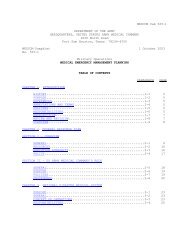(MCD) Guidelines
(MCD) Guidelines
(MCD) Guidelines
Create successful ePaper yourself
Turn your PDF publications into a flip-book with our unique Google optimized e-Paper software.
<strong>Guidelines</strong> for Military Mass Casualty Decontamination Operations<br />
During a Domestic HAZMAT/Weapon of Mass Destruction Incident<br />
stores hazardous materials. Should a release occur from such a facility, <strong>MCD</strong> could<br />
certainly be required during the response phase.<br />
The risks from CBRN weapons and commercial, industrial, and medical hazards<br />
have increased over the years. Agent contamination can occur as a result of a direct<br />
attack or an accidental release. Chemical, biological, and radiological materials can<br />
be released in the following forms, which impacts how <strong>MCD</strong> operations are<br />
performed: 15,23<br />
• Vapors are substances that exist in gaseous form at atmospheric pressure. They<br />
can be dispersed by generators or bursting munitions. They generally disperse<br />
rapidly in an open or outdoor area, and cause widespread contamination indoors.<br />
• Aerosols are liquid or solid agents divided into small particles suspended in a<br />
gaseous medium. They behave much like vapors. Examples include mist, fog, or<br />
smoke.<br />
• Liquids can range from thick and sticky to the consistency of water.<br />
• Solids range from radioactive material, biological spores, and powder agents.<br />
5.1 Toxic Industrial Materials<br />
A toxic industrial material (TIM) is a generic term for toxic or radioactive substances<br />
in solid, liquid, aerosol, or gaseous form. These may be used or stored for industrial,<br />
commercial, medical, military, or domestic purposes. They are described as a toxic<br />
industrial chemical (TIC), toxic industrial biological (TIB), or toxic industrial<br />
radiological (TIR). 27<br />
TICs are used throughout the country from households to industry. Production of<br />
most chemicals keeps rising, according to statistics from various government<br />
agencies and trade associations. 28,29 TICs, such as ammonia, sulfuric acid, chlorine,<br />
and pesticides, are transported by highway, railway, waterway, and airway. TICs are<br />
also widespread throughout the world. U.S. forces use area studies, intelligence<br />
estimates, and/or economic studies to indicate TICs available and potential hazards<br />
in an area of operation.<br />
A TIB is any biological material made, used, transported, or stored for any processes<br />
in industry, medicine, or commerce. These materials are used in clinical research,<br />
medical industry, and pharmaceutical manufacturing. These substances damage<br />
vegetation and can be toxic to humans and animals. 15,30 A TIR is any radiological<br />
material made, used, transported, or stored for any processes in industry, medicine,<br />
or commerce. These materials are used in research, generation of electricity, and<br />
medical tests and treatments. Such materials include pharmaceuticals, medical<br />
sources, and even spent fuel rods. TIRs damage vegetation and can be toxic to<br />
humans and animals. 15,30<br />
The threat of a purposeful or accidental release of a TIC onto a population is more<br />
likely than a threat from a release of a TIB or TIR because TICs are readily used in<br />
industry. Accordingly, these <strong>Guidelines</strong> largely focus on an <strong>MCD</strong> incident resulting<br />
8 Original



